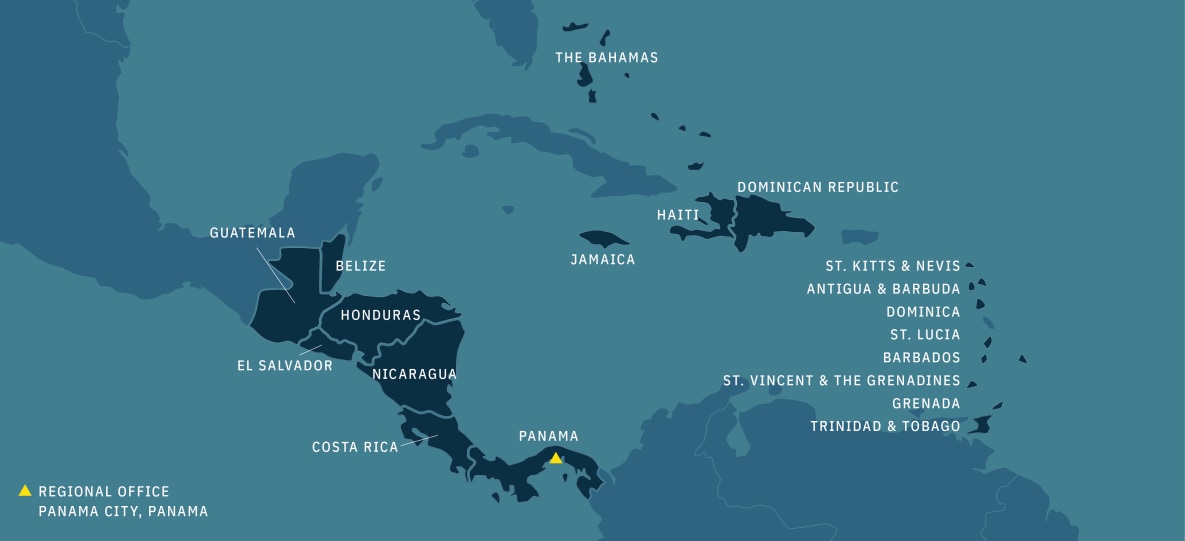CDC’s Central American and Caribbean Regional Office

At a Glance
Established in 2023, U.S. CDC’s Central America and Caribbean Regional Office (CACRO), located in Panama City, Panama, is positioned to build on CDC’s longstanding critical work in the region, including HIV/AIDS and tuberculosis programming. U.S. CDC aims to advance regional health security by addressing transnational health threats, and is partnering with regional health organizations to support capacity building and systems strengthening in data modernization, vector-borne diseases, and migration.
Overview
CDC has collaborated with public health institutions in Central America and the Caribbean since the 1960s. Initially, the focus was on parasitic diseases in Central America and arboviruses in the Caribbean. In 2003, CDC established a Central America Office in Guatemala and a Caribbean Office in 2006 in Trinidad and Tobago. The Caribbean Office later relocated to Bridgetown, Barbados in 2008 before finally settling in Kingston, Jamaica in 2015.
In 2023, CDC established a new regional office covering Central America and the Caribbean in Panama. The Central America and Caribbean region is home to more than 205 million people and spans seven Central American and 15 Caribbean countries. Both Guatemala and Jamaica will continue to support programmatic activities throughout the region, including HIV/AIDS and tuberculosis programming through the President’s Emergency Plan for AIDS Relief (PEPFAR) and the global health security agenda (GHSA) activities. The Dominican Republic and Haiti Country Offices will become part of the regional platform supported by the Regional Office in Panama while continuing to lead bilateral programming their respective countries.
The goal of the CDC Central America and Caribbean Regional Office (CACRO) will be to build on the critical work from the Dominican Republic, Haiti, Jamaica and Guatemala. CACRO aims to advance the regional health security goals by addressing transnational health threats that emerge in either subregion. CACRO will preliminarily focus on urgent global health policy initiatives directly linked to the Agency’s strategic priorities—specifically climate and health including One Health, health equity and emergency preparedness and response. The regional office will partner with regional health organizations to support member states capacity building and systems strengthening in data modernization. This includes health information systems, surveillance and data forecasting. In addition, the office will address important regional issues such as vector-borne diseases and migration.
-
- Belize
- Costa Rica
- El Salvador
- Guatemala
- Honduras
- Nicaragua
- Panama
- Antigua and Barbuda
- The Bahamas
- Barbados
- Dominica
- Dominican Republic
- Grenada
- Guyana*
- Haiti
- Jamaica
- Saint Lucia
- St. Kitts and Nevis
- St. Vincent and the Grenadines
- Suriname*
- Trinidad and Tobago
*As CARICOM member states situated in the South American continent, Guyana and Suriname will be jointly covered by the South America and Central America and Caribbean Regional Offices.
Key Areas of Focus
Reflecting U.S. CDC’s Global Health Strategy, CACRO is focused on responding to health threats by building core public health capacities in:
- Public health surveillance and data use
- Laboratory systems strengthening
- Workforce development and human resources for health
- Emergency preparedness and outbreak response, including forecasting
- Border health and migrant health
- Antimicrobial resistance
- Health equity
- Climate and health, including One Health
CDC and partners coordinate closely and work together on strategic areas that reflect the agency-wide Global Health Strategy and include coordinated partnerships, trained workforce, and prepared systems to achieve the following goals:
- Goal 1: Enhance existing, and develop new partnerships to improve regional health security coordination, collaboration, and communication
- Goal 2: Strengthen public health and clinical laboratory systems serving human and animal sectors
- Goal 3: Strengthen data modernization initiatives through surveillance and health information systems to understand disease trends, detect public health threats and conduct predictive analyses for forecasting
- Goal 4: Promote public health science and research to ensure policy, guidelines and recommendations are evidence-based
- Goal 5: Strengthen health equity by improving the quality of and accessibility to essential public health services for all – including indigenous populations and migrants